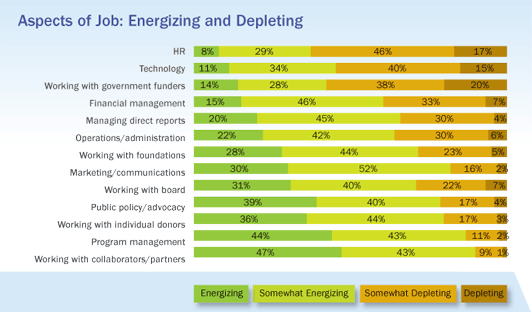Executive Wellbeing
Jun 13, 2011 by Marla Cornelius in Executive Wellbeing
These are the key findings from Daring to Lead 2011 related to executive director wellbeing: job satisfaction and effectiveness, work-life balance, burnout, and isolation. For more information download the full report in PDF. And also see, Inside the Executive Director Job: Daring to Lead Brief 2.
Job Satisfaction — Executives reported very high levels of job satisfaction: 91% said they are very happy in their jobs (45%) or have more good days than bad (46%). After an initial honeymoon phase during which 52% of leaders in the role for less than a year described themselves as very happy, just 37% identified that way during years one through three. As with happiness in the job, satisfaction with board performance was lowest among leaders on the job between one and three years.
Job Aspects: Energizing and Depleting — Executives reported being energized by programmatic work, as well as work that engages them externally in partnerships and collaboration, in marketing and communications, and in policy and advocacy. Internal operational aspects of their roles were more likely to be depleting, especially human resources and technology. When asked how energized or depleted they were by their work with three kinds of funders—individual donors, foundations, and government agencies—leaders were dramatically more likely to be depleted by their work with government funders. Fifty-eight percent (58%) of executives reported government funding relationships as somewhat depleting or depleting compared with 28% and 20% for foundations and individual donors respectively.
Time spent on Core Job Functions — The three areas that executives were most likely to report not spending enough of their time are communications and public relations (54%), fundraising (53%), and networking and partnership (52%).
How executives spend their time is significantly influenced by whether their organizations are large enough to have dedicated management staff across core functions. For instance, many nonprofits with staff sizes under 25 people are large enough to have multiple programs and diverse revenue streams—leading to potential complexity in finance, human resources, and fundraising—but unable to afford senior positions in all of these arenas. In organizations of 6-25 staff members, there were only two functions for which a majority of executives reported having a senior manager other than themselves with primary responsibility, program (73%) and finance (53%).
Leadership Effectiveness — The majority of leaders assessed themselves as effective or very effective in all four leadership domains: Leading self (94%), leading others (89%), leading the organization (91%), and leading externally (86%). The domain where the smallest percentage (35%) assessed themselves as very effective was leading others.
Burnout — Levels of burnout, especially given the economic climate, were relatively low; 67% of leaders reported little or no burnout at all.
Work-life Balance — Forty-seven percent (47%) of executives reported having the work-life balance that’s right for them, while a significant minority (39%) said they did not.
Isolation — Seventy percent (70%) of executives reported some degree of loneliness at the top; 30% reported that they are not at all isolated.
Gender Differences — Indicators of executive well-being differ significantly among men and women. Men report burnout at half the rate of women and are significantly more likely to report having the work-life balance that’s right for them.
Recession Impact on Executives — Sixty-five percent (65%) of executives reported significant levels of recession-related anxiety. Thirty-three percent (33%) of executives with less than one month of reserves reported high recession-related anxiety, compared with 15% among executives with six months or more. Recession anxiety was strongly associated with executive burnout. Overall, 9% of executives described themselves as very burned out, compared to 19% of leaders with high levels of recession anxiety.
